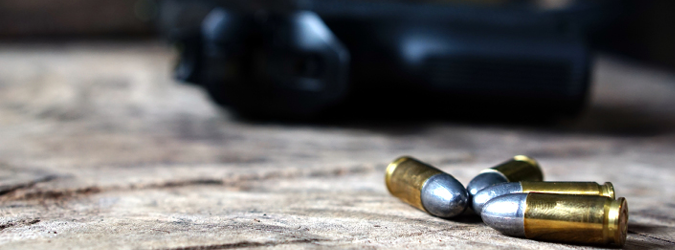Tools To Help Clients Dealing With Domestic Violence
7.25.2023

Statistics on gun violence bear the grim reality that cases of domestic violence turn deadly more often if there are firearms in the home.
“Having a gun in the home increases the risk of homicide 20 times when there is a history of domestic violence,” says Ronell McGlothan, a domestic violence advocate coordinator at the YWCA. “Even the presence of an unloaded weapon in the home can be used for intimidation by an abuser.”
A recent seminar held at the New York State Bar Association Partnership Conference in Albany took a step beyond the statistics to show lawyers and victims’ advocates how to use state and federal law to help their clients survive and hopefully escape partner violence.
Bob Passonno has made a career in law enforcement, first as a police officer for 20 years, now as criminal justice trainer at the New York State Office for the Prevention of Domestic Violence.
The goal of the agency is to enhance the safety of all New Yorkers in their family and household relationships. Dressed head to toe in purple in solidarity with domestic violence survivors, he challenges the attorneys to look at the issue of domestic violence with a broad scope.
“This country has such a problem with domestic violence that we don’t seem to be willing to wrap our arms around,” he says. “Police and prosecutors can’t do this alone. We cannot arrest our way out of this problem.”
Weapon vs. Firearm
New York State law does not have a definition for a weapon or a gun, but it does have one for a “dangerous instrument.” It is defined as any instrument, article or substance including a vehicle that can cause death or serious physical injury. [1]
Not all guns are firearms, says Passonno, but according to New York State law, a firearm is defined as a “deadly weapon.”[2] The definition is a loaded weapon that is capable of causing death or serious injury and can also include weapons such as knives and brass knuckles. In New York State, a firearm is classified as a handgun, sawed-off shotgun or rifle and an assault weapon. A hunting rifle, shotgun or an antique firearm is not classified as a firearm under the law. It’s important to understand the distinction.
Recent Revisions to the SAFE Act
The gun control measure passed in New York in 2013 shortly after the school shooting in Sandy Hook, Connecticut, became a national story. It ushered in new regulations including the ability for a judge to suspend or revoke firearms licenses and order the immediate surrender of firearms, rifles and shotguns when dealing with a defendant who may harm themselves or others.
A judge is permitted to suspend or revoke a firearm when issuing an order of protection or following a violation of an order. In 2020, the New York State legislature clarified this section by changing the wording from “the court may revoke” to “the court shall revoke” a firearms license. The revision included “the court shall order an immediate seizure” of weapons if the defendant may harm the person named in a protection order.
Stalking and Strangulation Laws
The SAFE Act provides for the court to seize firearms following a conviction for stalking and strangulation. Passonno says enforcement of stalking laws can go a long way to slowing the progression of violence. Since the passage of the state’s stalking law in 1999, Passonno says New York State has only seen 35,000 stalking arrests.
“I dare to say that every domestic violence case involves some stalking,” he said. “[Stalking] is unwanted pursuit of another person. Domestic violence victims are being stalked every single day of their lives.”
In contrast, the strangulation or obstruction of breathing law passed in 2010 is widely used, accounting for 160,000 arrests in the last 12 years.
Extreme Risk Protection Order (ERPO) or Red Flag Order
Amy Schwartz-Wallace, senior attorney with the Empire Center for Public Policy of New York explained the uses of an Extreme Risk Protection Order (ERPO), commonly called the “red flag law.”
Like the revocation of a permit or license, an ERPO is a court order issued when a person is a danger to themselves or others. It prohibits a person from buying firearms and requires they surrender weapons they already possess. An ERPO can direct police to search a person or location. It’s a civil matter, not a criminal matter.
An ERPO may be commenced by school officials, medical providers and by family members of the unstable person. The law was signed in 2019 and was revised in 2022 following the TOPS Supermarket shooting in Buffalo. Then, Gov. Kathy Hochul signed an executive order amending the act that an ERPO “must be commenced” by a district attorney or police officer if they have credible evidence of a person wishing to harm themselves or others. The New York State Legislature later codified the executive order into law.
Since 2022, Schwartz-Wallace says the number of applications for an ERPO has increased dramatically. While the cost to file may seem high at first glance, Schwartz-Wallace says the strategy is more successful in the long run.
“When counseling your client, consider the cost of over $200 to file an ERPO,” she says. “If your client is concerned about firearms and other weapons in the home, an ERPO may be the way to go before getting a temporary restraining order.”
|
Red Flag Lethality Indicators · Past History of Domestic Violence |
| · Access to Firearms |
| · Past Case of Non-Fatal Strangulation |
| · Separation Attempts in the Relationship |
| · Threats of Suicide |
| · Evidence of Escalating Violence
· Broken Doors and Windows · Threats to Kill |
Safety Planning with your Client
Ronell McGlothan has seen domestic violence from many vantage points, from meeting clients at the police precinct to the Family Court to those in recovery where she works as an advocate coordinator at the Schenectady YWCA.
She wrapped up the seminar with a discussion on how to work with a client on a safety plan. The safety plan should be individualized to the person’s experience and created with the client, not for the client. It may change over time to reflect the current situation.
“Victims do not have control over their partner’s violence, but they can find ways to reduce their risk of harm,” she says.
Establishing independence in your client can start with a savings account and a new credit card in the client’s name. McGlothan advises that clients collect and store clothing and important documents such as insurance cards, working papers and cash outside of the home. Identify a safe place, such as a friend’s home, to store these items. Tell a trustworthy neighbor about the violence and ask them to call the police if they hear a disturbance.
Helping a Survivor’s Children
Teaching children simple skills can make a difference in navigating domestic abuse.
“Teaching your kids how to use the phone, how to get help and strategies for getting out of the house,” said McGlothan.
She shared an example where a client used a code word with her kids that alerted them to leave the house and go to the trusted neighbor’s home. The client was able to escape and join the children at the safe house. She advises adults and children to practice the escape route, just like you would with a fire drill.
Inform the children’s school or daycare center about the situation. They can be an additional support for both the parent and the children. Finally, McGlothan advises her clients to disable locating functions on their phones to prevent abusers from tracking them.
Schwartz-Wallace reminds attorneys to think of all of these options as tools. “Think about which weapons the abuser has and carefully choose your weapons to use in the legal system.”
[1] penal law 10.00 (13)
[2] penal law 10.00 (12)
Editor’s note: This article stems from a session held during the NYSBA Partnership Conference on October 20, 2022. The seminar was recently made available as a CLE video titled “Firearms and Gun Violence: Practical Considerations for a Changing Regulatory Landscape.”







One comment
Very well-written article and hearing insight from multiple viewpoints provided terrific perspective.